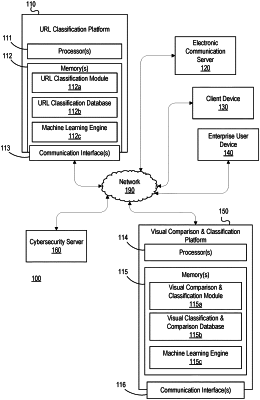| CPC H04L 63/1483 (2013.01) [G06F 16/51 (2019.01); G06F 16/9566 (2019.01); G06F 18/213 (2023.01); G06F 18/217 (2023.01); G06F 21/56 (2013.01); G06N 3/08 (2013.01); G06N 20/00 (2019.01); G06N 20/10 (2019.01); H04L 63/1408 (2013.01); H04L 63/1416 (2013.01); H04L 63/1441 (2013.01); G06V 2201/09 (2022.01)] | 20 Claims |

|
1. A computing platform, comprising:
at least one processor;
a communication interface communicatively coupled to the at least one processor; and
memory storing computer-readable instructions that, when executed by the at least one processor, cause the computing platform to:
identify, by parsing a uniform resource locator (URL), one or more human-engineered features of a URL, wherein the one or more human-engineered features comprise one or more of: a protocol, a top level domain (TLD), a domain, a subdomain, a port, a port type, a path, or path components;
identify one or more deep learned features of the URL;
concatenate the one or more human-engineered features of the URL to the one or more deep learned features of the URL, resulting in a concatenated vector representation;
compute, by inputting the concatenated vector representation of the URL to a URL classifier, a first phish classification score;
in response to determining that the first phish classification score is between a first phish classification threshold and a second phish classification threshold, cause image data for the URL to be sent to a visual similarity classification platform, configured to produce a computer vision vector representation of the image data and a corresponding second phish classification score; and
in response to determining that the second phish classification score exceeds the first phish classification threshold, cause a cybersecurity server to perform a first action.
|